A gemba walk is a key practice for leaders and managers who want to see processes firsthand and engage with teams on the shop floor. It emphasizes observing operations directly rather than relying solely on reports or data. By being present where work happens, managers can identify inefficiencies, uncover opportunities for improvement and build stronger communication with employees.
The gemba walk also fosters a culture of continuous improvement and accountability. Teams feel heard when leaders take the time to observe, ask questions and offer guidance. Regular walks create actionable insights and help align operations with strategic goals, ensuring processes run smoothly and effectively.
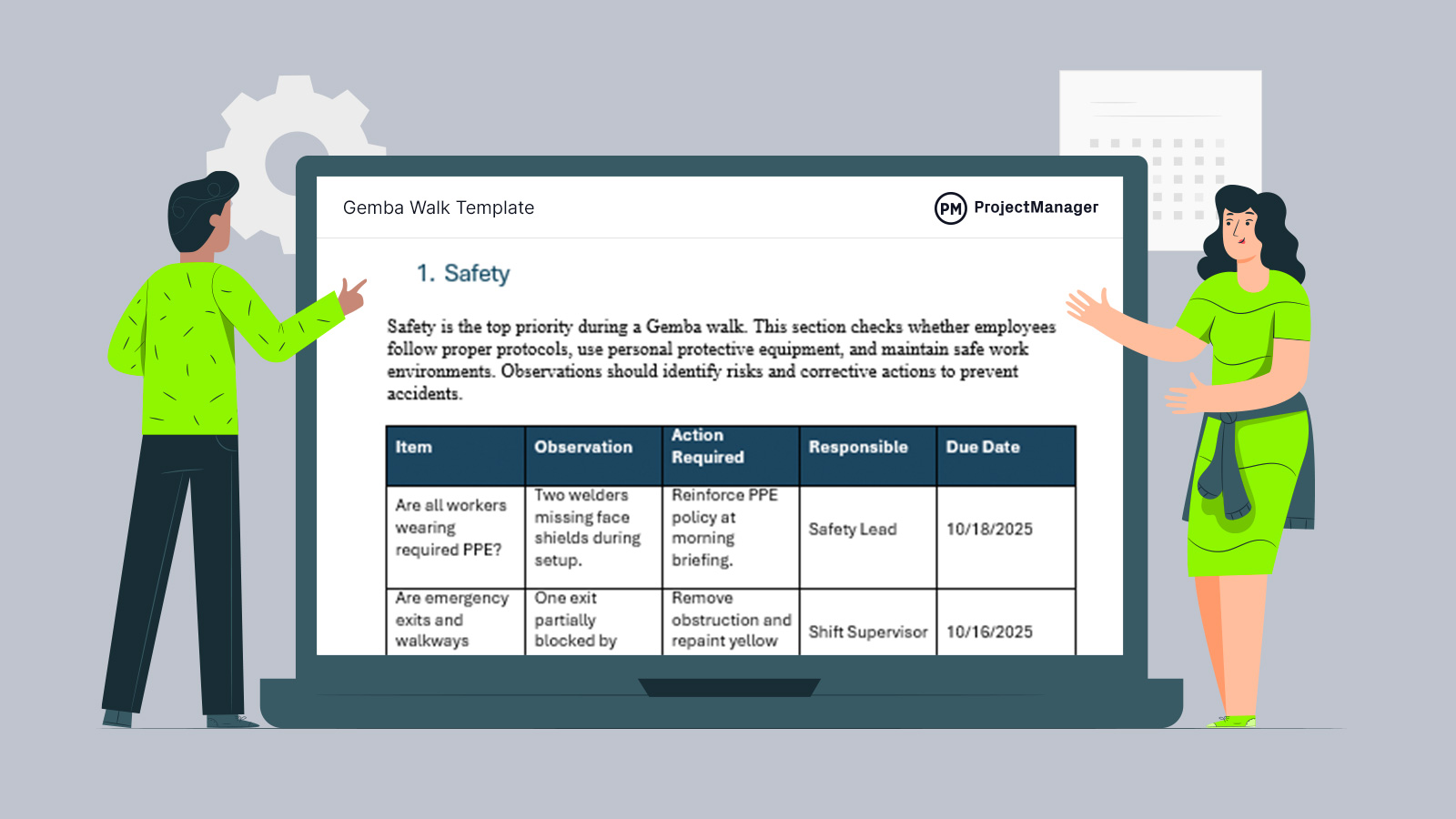
Get your free
Gemba Walk Template
Use this free Gemba Walk Template to manage your projects better.
Get the Template
What Is a Gemba Walk?
A gemba walk is a hands-on practice where leaders go to the place where work happens to observe operations directly and engage with the people doing the job. The purpose is to see real conditions, ask constructive questions and gather firsthand information rather than rely only on reports and secondhand summaries. By witnessing processes in person, leaders can spot waste, understand workflow issues and build trust with frontline teams.
During a gemba walk, observers focus on understanding the current process, identifying variances from expected performance and looking for opportunities to improve safety, quality and efficiency. The activity is rooted in continuous improvement and problem solving, using observation to trigger follow-up actions such as root cause analysis, corrective plans and simple experiments to test improvements. Regular gemba walks create a rhythm of learning and accountability that supports sustained operational gains.
Project management software helps make gemba walks more actionable by turning observations into tracked tasks with owners’ deadlines and priority levels. Observations captured on the shop floor can be logged from mobile devices with photos, notes and attachments then assigned to the right person for resolution. Dashboards and reports consolidate findings across multiple walks so leaders can spot trends, measure follow-through and ensure improvements are implemented and sustained.
ProjectManager is ideal for teams that use gemba walks because it combines mobile capture, customizable checklists and multiple project views to manage observations and improvement work. Use task lists or kanban boards to assign and track corrective actions, Gantt charts to schedule follow-up activity and dashboards to report impact. AI-driven insights highlight patterns and recommend actions, helping leaders prioritize high-value fixes and demonstrate measurable gains from their gemba walk program. Get started with ProjectManager today for free.

What Is the Purpose of a Gemba Walk?
The purpose of a gemba walk is to connect leadership with the actual work environment to see how processes function in real time. It allows leaders to observe workflows, understand challenges and identify inefficiencies that may not appear in reports. A gemba walk encourages collaboration by opening direct communication between management and frontline teams, building trust and mutual respect. Its ultimate goal is to drive continuous improvement, eliminate waste and promote a culture where every employee contributes to operational excellence and problem-solving through open feedback and shared learning.
How to Do a Gemba Walk: Step-by-Step Process
Conducting a gemba walk involves preparation, observation and follow-up. The goal is not to evaluate performance but to understand the process and discover opportunities for improvement. By following these key steps, leaders can perform an effective gemba walk that identifies root causes, reinforces employee engagement and transforms insights into meaningful actions that enhance efficiency, safety and quality throughout the organization.
1. Define Purpose and Objectives for the Gemba Walk
Start by identifying the purpose and objectives of your gemba walk. Determine what process, department or area you want to observe and what you hope to achieve. Common objectives include improving safety, reducing waste or increasing quality. Setting a clear purpose helps focus your attention during the walk and ensures your observations align with business priorities. This clarity also makes post-walk analysis more effective and actionable.
2. Plan the Walk: Define the Where, When and Who
Effective planning ensures a productive gemba walk. Select the specific area or process to visit, choose a suitable time when normal operations are occurring and identify who should participate. Include supervisors, managers and relevant team members who can explain daily workflows. Avoid scheduling walks during special events or irregular shifts. Planning helps create a structured approach that keeps the walk efficient and relevant to real operational conditions.
Related: 18 Free Project Planning Templates for Excel and Word
3. Make a Gemba Walk Checklist
A gemba walk checklist keeps the process consistent and focused. It outlines what to observe, such as safety practices, workflow sequence or equipment performance. The checklist helps prevent overlooking key aspects and ensures that observations align with the walk’s goals. A well-designed checklist also makes it easier to record findings, compare results over time and communicate insights effectively to other stakeholders or departments after the walk.
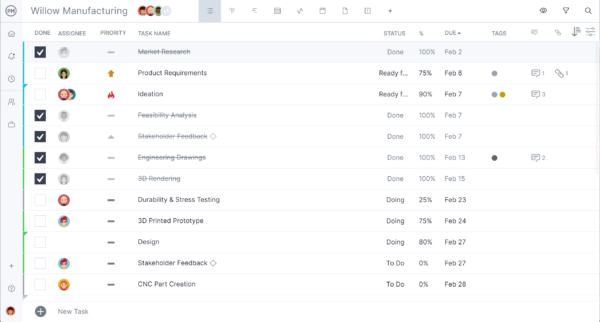
4. Engage with Employees During the Gemba Walk
During the gemba walk, engage employees respectfully and with curiosity. Ask open-ended questions about their work, challenges and ideas for improvement. The goal is to listen, not to judge or correct. Encouraging dialogue builds trust and provides valuable insights into real issues that affect productivity. Employee engagement also reinforces a culture of collaboration where everyone feels ownership in improving the process and achieving shared operational goals.
5. Analyze and Document Findings
After the walk, gather and analyze your notes, photos and feedback. Identify recurring problems, inefficiencies and potential risks that were observed. Organize your findings by theme to understand root causes and patterns. Documentation is essential because it provides a factual basis for decisions and action plans. Accurate records also help track progress over time and measure the impact of improvements made as a result of the gemba walk.
6. Follow Up and Take Actions
Once analysis is complete, prioritize issues and assign corrective actions to the responsible team members. Develop timelines, allocate resources and monitor progress to ensure improvements are implemented effectively. Following up shows commitment and accountability, reinforcing the value of the gemba walk. Sharing results with employees closes the feedback loop, encourages ongoing participation and turns insights into measurable, lasting improvements in operations and workplace culture.
Related: 10 Free Productivity Templates
Gemba Walk Template
Download this free gemba walk template for Word to have a ready-made framework for managers and team leaders to conduct structured observations on the shop floor. The template includes all essential categories such as Safety, Work Process, Quality, Productivity and Flow, 5S / Workplace Organization, Communication and Teamwork and Continuous Improvement.
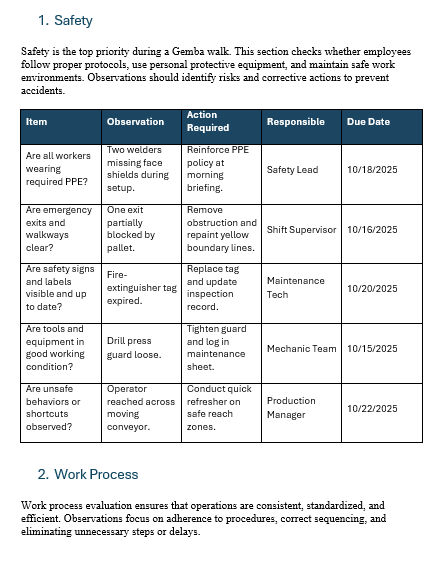
Each section is designed to guide users in identifying issues, recording observations, assigning responsibilities and tracking corrective actions. With prebuilt tables for items, observations, required actions, responsible personnel, due dates and status, the template ensures nothing is overlooked during the walk.
Gemba Walk Checklist
A gemba walk checklist ensures that leaders observe the most critical aspects of the workplace consistently. It provides structure for evaluating safety, workflow, quality and communication while encouraging collaboration and improvement. By following a well-organized checklist, managers can capture actionable insights, identify problem areas quickly and reinforce standards that drive operational excellence and employee engagement.
1. Safety
Safety is the foundation of every gemba walk. This category ensures that all employees are protected and that work areas meet established safety regulations. Observing safety practices helps identify risks, prevent incidents and create a culture of accountability. It also reinforces the organization’s commitment to employee well-being, compliance and operational stability while maintaining productivity in a secure environment.
- Are all workers wearing the required PPE?
- Are emergency exits and walkways clear?
- Are safety signs and labels visible and up to date?
- Are tools and equipment in good working condition?
- Are unsafe behaviors or shortcuts observed?
2. Work Process
The work process category focuses on how tasks are performed and whether standard procedures are being followed. It evaluates consistency, timing and adherence to established workflows. Observing the process in real time reveals inefficiencies such as unnecessary movements or waiting times. Understanding these patterns helps streamline operations, improve training and ensure that each task supports broader production goals.
- Is the standard work instruction visible and being followed?
- Are steps being done in the correct sequence?
- Are cycle times consistent with the standard?
- Are there unnecessary motions or waiting periods?
- Are materials and tools positioned for easy access?
3. Quality
Quality ensures that products and services meet expectations and comply with defined standards. During a gemba walk, this category helps identify where defects occur and how quality control measures are applied. Observing quality practices helps verify that workers understand inspection points, recognize defects and take corrective action. Maintaining high quality reduces waste, customer complaints and rework costs.
- Are there visual quality standards at the workstation?
- Are defects visible or segregated?
- Are inspection points clearly defined?
- Are workers trained to identify and report defects?
4. Productivity & Flow
Productivity and flow measure how efficiently work moves through each stage of production. This category identifies bottlenecks, idle time or overproduction that disrupts the workflow balance. Observing material movement and task timing ensures that resources are used effectively. A smooth, continuous flow improves output, reduces delays and enhances coordination across departments and teams.
- Is workflow continuous without bottlenecks or idle time?
- Is there excessive WIP (work in progress)?
- Are material deliveries timed with demand?
- Are there delays between tasks or departments?
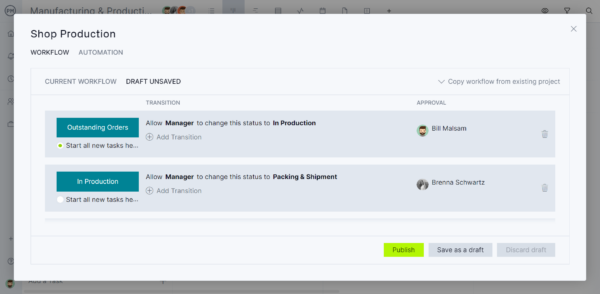
5. 5S / Workplace Organization
The 5S category evaluates how organized, clean and efficient the workplace is. It covers sorting, setting in order, shining, standardizing and sustaining. Proper organization helps minimize waste, reduce search times and promote safety. Observing 5S practices provides insights into workplace discipline and how well visual management tools are maintained to support daily operations.
- Are tools and materials labeled and stored correctly?
- Are floors and surfaces clean and free of debris?
- Are visual management boards current and accurate?
- Are unused items or waste materials present?
6. Communication & Teamwork
Communication and teamwork are essential for effective collaboration and problem-solving. This category ensures that goals are understood, progress is tracked and information is shared transparently. Observing how teams communicate helps identify gaps in coordination or knowledge transfer. Strong communication fosters alignment, accountability and an engaged workforce that actively contributes to continuous improvement.
- Are production targets and KPIs displayed and updated?
- Do workers understand current goals or issues?
- Are shift handovers documented or communicated clearly?
- Are improvement ideas collected or discussed regularly?
7. Continuous Improvement
Continuous improvement evaluates how well teams identify, address and prevent recurring issues. This category tracks how problems are documented, solutions implemented and results sustained. A culture of continuous improvement encourages proactive problem-solving and innovation. During a gemba walk, observing improvement efforts helps leaders assess engagement, follow-up discipline and the visibility of progress across all departments.
- Are problems logged and assigned for follow-up?
- Are countermeasures or corrective actions visible?
- Are improvement projects active and tracked?
- Is management support visible and consistent?
Gemba Walk Example
The following example shows how a gemba walk checklist can be structured and completed during an actual site observation. Each table represents a key focus area—from safety and process control to communication and continuous improvement. Use it to capture real conditions, identify gaps and document actions for follow-up. This format keeps observations organized, assigns responsibility and ensures accountability, helping teams turn insights from the gemba into measurable performance improvements.
Gemba Walk Checklist
A gemba walk checklist helps managers and supervisors observe operations in real time, identify process gaps and promote continuous improvement. This structured approach ensures every area of the workplace is evaluated consistently for safety, quality and efficiency.
1. Safety
Safety is always the first focus during a gemba walk. Observing safety conditions in person helps detect risks that reports might overlook. Use this checklist to verify that employees follow protocols and that the environment remains hazard-free.
| Item | Observation | Action Required | Responsible | Due Date | Status |
| Are all workers wearing required PPE? | Two welders missing face shields during setup. | Reinforce PPE policy at morning briefing. | Safety Lead | 10/18/2025 | Open |
| Are emergency exits and walkways clear? | One exit partially blocked by pallet. | Remove obstruction and repaint yellow boundary lines. | Shift Supervisor | 10/16/2025 | Completed |
| Are safety signs and labels visible and up to date? | Fire-extinguisher tag expired. | Replace tag and update inspection record. | Maintenance Tech | 10/20/2025 | In Progress |
| Are tools and equipment in good working condition? | Drill press guard loose. | Tighten guard and log in maintenance sheet. | Mechanic Team | 10/15/2025 | Completed |
| Are unsafe behaviors or shortcuts observed? | Operator reached across moving conveyor. | Conduct quick refresher on safe reach zones. | Production Manager | 10/22/2025 | Open |
2. Work Process
This section focuses on how work is actually being done versus how it was designed. The goal is to see if employees follow the standard process, identify inefficiencies and ensure instructions are clear and practical.
| Item | Observation | Action Required | Responsible | Due Date | Status |
| Is the standard work instruction visible and being followed? | Printed SOP posted but faded. | Replace laminated copy at workstation. | QA Coordinator | 10/17/2025 | Completed |
| Are steps being done in the correct sequence? | Step 3 (torque check) skipped on one unit. | Retrain operator on correct sequence. | Line Lead | 10/19/2025 | Open |
| Are cycle times consistent with the standard? | Average cycle = 7.5 min (target 6 min). | Analyze delay cause; consider adding fixture. | Process Engineer | 10/25/2025 | In Progress |
| Are there unnecessary motions or waiting periods? | Operator waits 45 sec for parts bin refill. | Sync material delivery with takt time. | Logistics Coordinator | 10/23/2025 | Open |
| Are materials and tools positioned for easy access? | Wrench set stored below waist level. | Reposition tools at waist height rack. | 5S Champion | 10/21/2025 | Planned |
3. Quality
Quality checks ensure that products meet standards and customers receive consistent value. During a gemba walk, focus on visual controls, defect handling and whether workers understand how to identify and report issues effectively.
| Item | Observation | Action Required | Responsible | Due Date | Status |
| Are visual quality standards at the workstation? | Current poster torn and outdated. | Print new visual aids from QA portal. | QA Assistant | 10/17/2025 | Completed |
| Are defects visible or segregated? | Defect bin missing red label. | Replace label and update zone map. | Line Supervisor | 10/16/2025 | Completed |
| Are inspection points clearly defined? | Gauge check not marked on control plan. | Add inspection step ID #14 to plan. | Quality Engineer | 10/20/2025 | In Progress |
| Are workers trained to identify and report defects? | New hires unsure about defect tags. | Hold 10-min training session on tagging. | HR Trainer | 10/18/2025 | Open |
4. Productivity and Flow
This category focuses on how efficiently work moves through the process. Observing flow, identifying bottlenecks and checking material timing all help maintain productivity and reduce waste during the gemba walk.
| Item | Observation | Action Required | Responsible | Due Date | Status |
| Is workflow continuous without bottlenecks or idle time? | Parts accumulate before station 4. | Investigate feeder speed mismatch. | Industrial Engineer | 10/22/2025 | In Progress |
| Is there excessive WIP (work in progress)? | Six units queued; limit = 3. | Enforce WIP limit with floor marking. | Production Lead | 10/17/2025 | Completed |
| Are material deliveries timed with demand? | Supplier cart arrives 30 min late. | Adjust milk-run schedule. | Logistics Planner | 10/19/2025 | Open |
| Are there delays between tasks or departments? | Assembly → Test hand-off lacks signal. | Install light-tower indicator. | Maintenance Team | 10/25/2025 | Planned |
5. 5S / Workplace Organization
Workplace organization under 5S principles ensures a clean, safe and efficient environment. During a gemba walk, evaluate how well the area supports productivity through visual order and cleanliness.
| Item | Observation | Action Required | Responsible | Due Date | Status |
| Are tools and materials labeled and stored correctly? | Labels peeling off drawers. | Replace with laminated labels. | 5S Coordinator | 10/18/2025 | In Progress |
| Are floors and surfaces clean and free of debris? | Oil spill near press. | Clean area and check leak source. | Custodian | 10/15/2025 | Completed |
| Are visual management boards current and accurate? | Downtime chart not updated for two days. | Assign daily update responsibility. | Shift Lead | 10/17/2025 | Open |
| Are unused items or waste materials present? | Scrap bin > 80% full. | Empty twice per shift. | Material Handler | 10/16/2025 | Completed |
6. Communication and Teamwork
Good communication and collaboration drive consistency across shifts and teams. This section checks how well goals are shared, issues tracked and improvements encouraged throughout the workforce.
| Item | Observation | Action Required | Responsible | Due Date | Status |
| Are production targets and KPIs displayed and updated? | KPI board shows last week’s data only. | Update daily metrics before 8:00 AM. | Production Lead | 10/16/2025 | Open |
| Do workers understand current goals or issues? | Operators unaware of rework reduction target. | Add rework rate goal to team briefing slides. | Operations Manager | 10/18/2025 | In Progress |
| Are shift handovers documented or communicated clearly? | Handover notes missing maintenance alerts. | Introduce mandatory checklist for end-of-shift. | Shift Supervisor | 10/19/2025 | Planned |
| Are improvement ideas collected or discussed regularly? | Idea board empty for 3 weeks. | Restart “idea of the week” incentive. | HR & Team Lead | 10/25/2025 | Open |
7. Continuous Improvement
The last part of the gemba walk focuses on sustaining improvements. Evaluate if problems are tracked, actions are visible and leadership actively supports follow-up and learning.
| Item | Observation | Action Required | Responsible | Due Date | Status |
| Are problems logged and assigned for follow-up? | Two machine stoppages not logged in Kaizen tracker. | Enforce issue logging policy after each downtime. | Maintenance Lead | 10/17/2025 | Completed |
| Are countermeasures or corrective actions visible? | Temporary fix applied, not documented. | Record corrective action in A3 report. | QA Engineer | 10/20/2025 | In Progress |
| Are improvement projects active and tracked? | 5S zone audit overdue by one month. | Reschedule monthly audit and post results. | Lean Coordinator | 10/22/2025 | Planned |
| Is management support visible and consistent? | No supervisor present during last two walks. | Reinforce attendance expectation for gemba walks. | Plant Manager | 10/24/2025 | Open |
Free Related Manufacturing Templates
These free manufacturing templates support operational planning, control and continuous improvement. Each template provides a structured format to capture critical information quickly so teams can act on insights, maintain consistency and improve efficiency on the shop floor.
Production Schedule Template
Download this free production schedule template to help plan daily and weekly production runs by mapping tasks, resources and timelines. It clarifies shift assignments, machine schedules and throughput targets so supervisors can balance capacity with demand and respond quickly to disruptions.
Inventory Template
Use this free inventory template to track stock levels, reorder points and lead times to prevent stockouts and reduce excess inventory. It provides fields for item descriptions, quantities on hand, safety stock and supplier details so purchasing and production remain aligned with demand.
SIPOC Template
The free SIPOC template captures Suppliers, Inputs, Process, Outputs and Customers in a single view to define process boundaries and align stakeholders. It is useful for scoping improvement efforts, clarifying requirements and ensuring teams share a common understanding before making changes.
ProjectManager Helps Manage Manufacturing Projects and Operations
ProjectManager supports manufacturers with flexible project views that match every role on the production floor and in management. That’s something templates can’t do. Teams can plan production runs on interactive Gantt charts, manage workflows with kanban boards and track maintenance tasks on calendars or lists. Each view stays connected in real time, ensuring changes made by one department instantly update across the entire platform to keep scheduling and communication aligned, which is beyond the functionality of a template.
Optimize Resource Management With Workload Charts and Team Pages
ProjectManager simplifies workforce planning by visualizing labor capacity through workload charts that reveal who’s over- or underallocated, and can balance workload to keep everyone productive. The team page centralizes schedules, availability and assigned tasks so supervisors can view daily and weekly tasks by priority or progress and update those tasks without leaving the page. This feature ensures machines, materials and staff are used effectively without causing burnout or downtime.
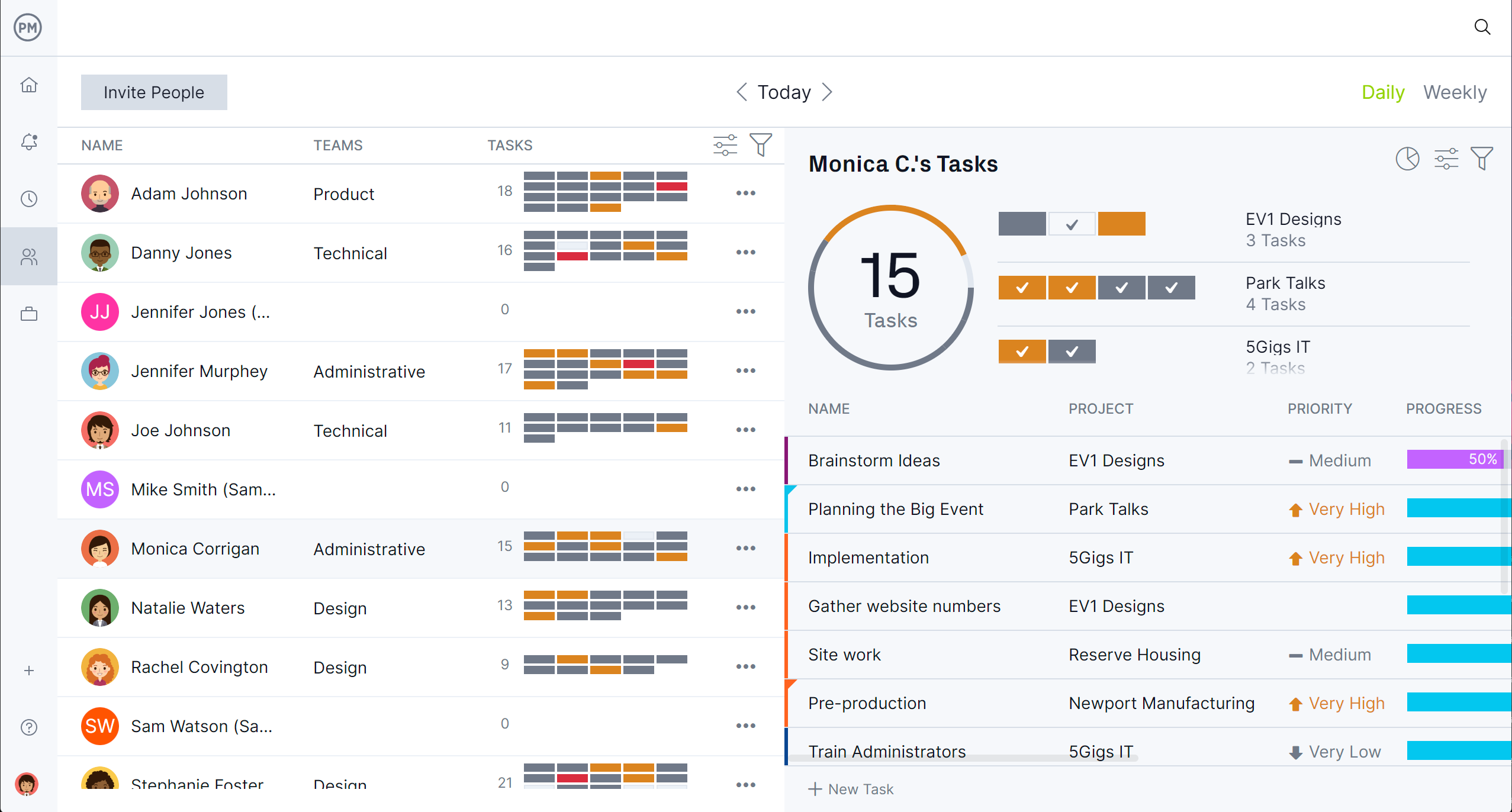
Track Production Performance With Real-Time Dashboards and AI Reports
Real-time dashboards and AI-powered reporting make tracking performance effortless. ProjectManager collects live data on production progress, cost and utilization, then visualizes it in customizable charts for quick decision-making. Built-in timesheets not only securely streamline payroll but also automatically calculate labor costs and provide managers with accurate cost insights to keep operations on budget while maintaining accountability across shifts.

Related Manufacturing Content
A gemba walk is important, but it’s only part of the larger manufacturing process. For readers curious to know more, check out the links below. They lead to articles on how to use a kamishibai board, the goals and challenges of project operations management and much more.
- Why Use a Kamishibai Board in Manufacturing?
- Production Operations Management: Goals & Challenges
- Production Forecasting Basics for Manufacturing Businesses
- 15 Top Methods of Production
ProjectManager is online project and portfolio management software that connects teams, whether they’re in the office or on the production floor. They can share files, comment at the task level and stay updated with email and in-app notifications. Get started with ProjectManager today for free.

